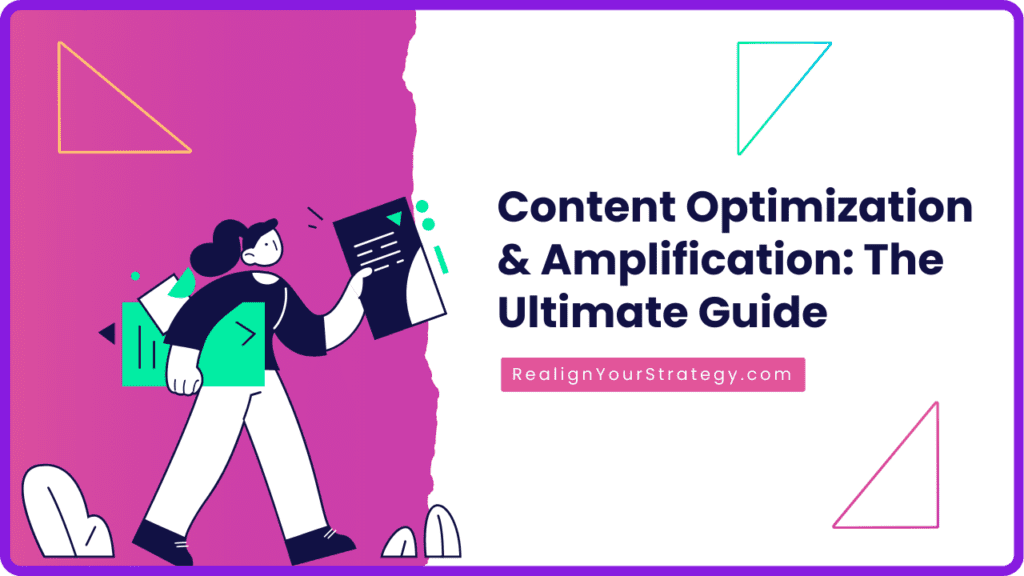Improving on what you’ve already done is generally easier than starting from scratch—which is why it’s vital to develop solid content optimization strategies for your business.
Sometimes, small and mid-sized business owners can feel pressured to constantly create new content for their websites or social media platforms. But that’s a recipe for burnout and contributes to the already overwhelming noise of the digital space.
In reality, staying relevant and visible to your audience does not require perpetually reinventing the wheel.

By optimizing and amplifying the content that’s already gotten some traction with your audience, you can conserve your energy for creating new content that is high-value and impactful.
Start by reviewing the strategies below. Then, devote about 30 minutes a day to content optimization and amplification. You’ll see more sustainable results that expand your reach and leave you feeling awesome about your work in the world.
Do you love checklists? Download our free Content Optimization Checklist here. And, be sure to bookmark this page as a reference as you work through these content optimization strategies.
Content Optimization: Helping Your Best Content to Shine
Effective content optimization strategies require the same expert eye as a gardener tending to their plants.

Like the flowers, trees, or vegetables that make up a garden, your website’s content has variety—and we’re not (only) talking about variation in topic or intent.
Some of your content has done well. It’s had some initial traction, resonated with your audience, and gotten some clicks. With some strategic pruning and the proper support, it can have the chance to truly flourish—like when you water and fertilize your prize flowers. That’s optimization.
Other pieces of your content have not done well. They were a flop with your audience, you’ve changed your view or business goals, or they’re simply outdated. You either need to completely rework these pieces or remove them—like when you repot or discard a struggling plant. This is also optimization.
Content optimization strategies improve the overall health and effectiveness of your website so that your best content can thrive.
With a bit of work here and there, your content can fulfill its purpose: expanding your reach in unexpected and incredible ways. Get started by downloading your free Content Optimization Checklist here.
Content Amplification: The Secret Weapon to Maximize Your Reach
If content optimization strategies are like helping your garden to flourish, then content amplification is akin to posting pictures of your favorite plants on social media, hosting a garden party, sharing home-grown vegetables with friends, or entering a flower-growing competition.
You’ve done all that work—now it’s time to show it off!
Amplifying your content means sharing it across various channels so that it reaches more people and expands your impact. Amplification can look like…
- social media posts
- email blasts
- paid advertising
- influencer outreach
- and more!

Sometimes, even our most compelling content can get lost in the digital ether unless we tell people where to look. So, be sure to have a plan for amplifying your content once you’ve worked through your optimization strategies.
Beyond Search Engine Optimization: Why Content Optimization Is Crucial for Your Success
Most businesses think of search engine optimization (SEO) when developing content optimization strategies. And while SEO sets the baseline, we must remember that we are writing and creating for people first, and search engine bots second.
After all, the audience using those search engines is human, with very real human goals and desires.
The best SEO strategies put people first.

When we choose keywords to integrate into our content, we should consider both search volume and the users’ search intention when entering that word or phrase.
Then, we expand our optimization strategy by remembering who we are creating content for, factoring in our business values, and adapting the content type for different purposes.
Strategic content optimization helps you serve a real purpose for your audience while maximizing your reach and conversion.
Ultimately, content optimization strategies are about providing value and attracting people who resonate with your work and the impact you’re working to create.
What is User-Generated Content, and How Is It Changing the Content Optimization Game?
One often overlooked type of content businesses should integrate into their optimization strategies is user-generated content, or UGC.
UGC is any content created by people not associated with your brand who have used your product or service.
User-generated content can be social media posts, YouTube videos, blog posts, online reviews, and more.
There are several benefits to user-generated content:
- Most of today’s consumers consider UGC to be more authentic, memorable, and impactful than other types of content marketing because it offers social proof of your brand’s claims.
- Content created by clients or customers is more cost-effective because it does not cost your company ad dollars or labor costs.
- When people see their content being celebrated and featured, they feel a greater sense of community and loyalty around your brand, which boosts word-of-mouth marketing.
- Integrating UGC content into your strategy can improve your online reach and visibility because search engines like Google favor fresh, high-value content.
Some companies have gotten creative about encouraging UGC that they can incorporate into their content optimization strategies.
Some ways to encourage UGC include…
- Using branded hashtags to make it easier to sort and share brand-supporting social media content.
- Hosting contests with incentives like discounts or exclusive access that challenge participants to create innovative content about how they use your products or services.
- Asking for reviews by providing easy-to-fill-out forms and gentle prompts or reminders via email or social posts.
Don’t underestimate the power of engaging with user-generated content and its creators.
Acknowledging and celebrating your customers’ contributions can ignite an enthusiastic community of raving fans.
How to Optimize Content for SEO: Our Guide for Beginners
Understanding basic SEO can form a solid foundation for your overall content optimization strategies. We always ensure each of our clients has a comprehensive keyword strategy. Then, we work on creating an intentional structure for the content to incorporate all the factors that will improve its online visibility.
Click from the list below to explore each feature of effective search engine optimization:
Strategize Your Website Content Production with Keyword Data
When someone searches for a word or phrase, the search engine bots look for the best answers to that query. That word or phrase is called a keyword.
Having an idea of the keywords your audience is using can help you create content they will find valuable. You optimize your content for this keyword by using it in key elements of the page—such as the title, subtitles, and metadata—and sprinkling it throughout the content.
For example, if you know your audience would benefit from an article about composting, you may look into keyword phrases like:
- how to start composting
- composting for beginners
- composting tips
- benefits of composting
- how to start composting
- composting for beginners
- composting tips
- benefits of composting
The exact phrase you choose should be based on two things: your understanding of your audience and keyword data.
Examining the data around keywords can help you determine how to make your content more visible to your target audience.
Tools like Google Search Console and Semrush can help you decide the best keywords for your particular brand.
Some factors to consider about each keyword include…
- Search volume: How often are people searching for this keyword?
- Keyword difficulty: How hard would it be to appear on the first page of search results with this keyword?
Having only one primary keyword (called a target keyword) for each page of your website is essential.
This way, search engines know exactly which page to pull for the search result. You avoid keyword cannibalization, which is when two or more pages on your website target the same keyword. Search engines do not see either as the authority, and they will rank lower than if they each had their own keyword.
Understanding Search Intent to Validate Your Content
The search intent of your chosen keywords is another critical component of your content optimization strategy.
When people enter a query into a search engine, they are looking for a specific kind of result. These results can be categorized as…
- Informational: The user wants information on how to do something, where a business is located, what something is, etc.
- Commercial: The user is considering a purchase in the near future and is looking for detailed information, product specifications, testimonials, etc.
- Transactional: The user is ready to make a purchase or take some other kind of action.
- Navigational: The user is looking for a specific website, such as Facebook or a local company.
If you create a page designed for people ready to invest in a service you offer, but you are using a keyword that people use when they are simply looking for information, you will get the wrong kind of traffic for your page—and very few conversions.
So, be sure you investigate the search intent of a keyword or phrase to ensure you are putting the right content in front of the right people at the right time.
Outlining and Structuring Your Content to Cover All the Gaps
Before you start writing—or when you’re optimizing already published content—take a step back and consider the overall structure.
People engage with digital content similarly to how they engage with newspapers or magazines: Rarely do they read every word, page by page, cover to cover.
Instead, they assess the cover to decide if they want to even start reading. For online content, the cover is equivalent to what viewers see before they have to start scrolling.
Then, people will quickly check out headlines, images, bolded text, and perhaps short bulleted lists. Many will move on after that, though a few will go back to engage with the content on a deeper level.

When outlining or restructuring your content, be sure that the most important and compelling points are present in your headlines and provide easily digestible details in the body text.
This type of structure respects your readers’ time. They can quickly determine if you’re providing what they’re looking for. If it is, this structure helps them more easily engage with your content.
Readability, Uniqueness, and Engagement
When planning your content, it’s critical to pay attention to what your competitors are doing—especially those that appear in search results under the same keyword.
To an extent, you want to provide similar content to match the search intent.
However, the ease with which users can engage with your content and your brand's unique spin will help you stand out from the competition.
With all of your content, be clear from the beginning who the content is for and what value you are providing. Use plenty of white space, contrasting colors for text, image alt text, and other features that make your content accessible to a wider audience.
And, lean into that thing that differentiates you from everyone else.
Maybe you provide additional features in your service that others do not. Perhaps you have a unique perspective that others can’t offer. Maybe how you engage with customers resonates with a particular audience.

When designing your content optimization strategy, be aware of what competitors are doing—so that you can provide even greater value.
How to Deal with AI While Considering Content Optimization Best Practices and Your Brand Values
There’s no question that AI is changing the game on content creation and search engine rankings. However, while AI-generated content has the potential to rank in search results, what ultimately matters is the value each piece of content offers.
Google and other search engines are primarily looking to provide the best answer to a user’s search query, no matter how the content is generated. (Dive deeper into how Google views AI-generated content here.)
Remember, even with content optimization strategies, we create for people first and search engines second. That means keeping your brand values top-of-mind.
Ultimately, the ways you do or don’t use AI—and exactly how you implement any content optimization strategies—will depend on what you stand for as a business.
We highly recommend outlining your company’s AI use policies now so that as you become more skilled at optimization strategies, you already know your line in the sand.
Optimizing Your Pages’ Metadata
Metadata is what appears when you search for something in Google or another search engine. Each result typically has a blue, linked title, followed by a description explaining the page’s purpose and how it answers your search query.
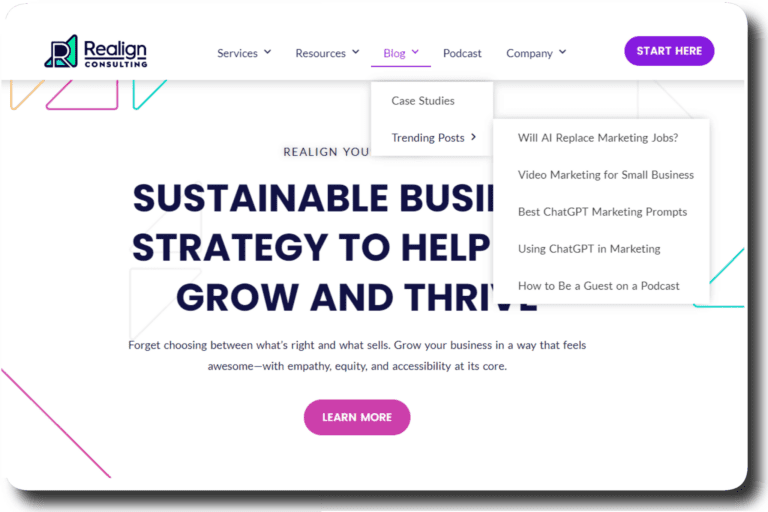
blog posts and case studies. This is just one way to create internal links on your website.
While it’s ultimately up to each search engine how it fills in the metadata for each page, we can influence the text they choose to use by writing our own meta titles and descriptions.
The key to effective metadata is to write something that will convince someone to click. Use your keywords and be clear about what visitors can expect from your content.
If you’re trying to write your metadata and coming up blank, consider these three things:
- What compels you to click when you’re doing your own searches?
- What trends do you see when you search for the target keyword for that content?
- What value are you providing with your content (answer, solution, entertainment, or other information)?
Adding Internal Links to Help Users and Search Engines Find Your Content
A common mistake we see when evaluating a client’s website for optimization is “orphan” pages. These are web pages that have not been linked to the website in any way, either in a menu or in the body text of another page.
When a search engine bot analyzes your website to determine how to answer user search queries, it starts with analyzing the main pages. Then, it accesses the other pages through your internal links.
If there is no link connecting your page to the rest of your site, it is practically invisible to search engines—and, therefore, your audience.

This is just one way to create internal links on your website.
Be sure to check your internal linking structure when designing your content optimization strategy. Also, keep in mind that not every page on your site needs to link directly to your menu. Linking the new page to text in an existing one (called a contextual link) is often enough.
Keeping Your Content Updated (When Applicable)
One of the biggest perks of optimizing your content is that it takes less time and resources than creating something new.
Before adding new content to your site, be sure to take the time to review what you’ve already created.
Sometimes, our content is “evergreen,” meaning it holds true no matter the season or year and does not need much, if any, updating.
However, much of our content can become outdated, especially if we refer to technology, systems, guidelines, etc. that can change over time.

For example, we’re pretty proud of our list of DIY Business Tools because we know it’s so hard to find things that work like they claim to.
But, technology changes, business needs change, and sometimes we find something new and awesome we want to share. So, we take a few minutes a few times a year to review this page for any necessary updates.
If you know a piece of content will need regular updating—or at least a semi-regular review—set up an alert in your calendar so you don’t forget.
Maximizing Your Content’s Power With Structured Data and Backlinks
Working with structured data and backlinks is a more advanced element of SEO than what we’ve covered above. If you feel confident with most of the other content optimization strategies, consider looking deeper into these features.
- Structured data is code you integrate into your web page’s HTML to better inform search engines of precisely what you’re providing with that page. Some examples of structured data (or schema markup) include FAQ, event, product, and review coding.
- Backlinks are links from other websites or places on the web to your website and its pages. Depending on who or what companies are linking to your site, backlinks can contribute to your site’s E-E-A-T, especially in terms of authority and trustworthiness.
If you’re not ready for this part of SEO right now, that’s fine. If you are, including these elements in your content optimization strategy can definitely maximize the chances of your content ranking well in Google and other search engines.
Local SEO Considerations: Creating Content for a Local Business
One of the most common types of online searches people conduct involves the words “near me.” If your business serves a local community, your content optimization strategies should include elements to support local search.
This type of optimization looks like…
- Updating your Google Business profile with your address
- Curating and displaying reviews from local clients (That’s user-generated content!)
- Adding your location to key places in your content
Each of these steps can help the people you are working to serve find you.
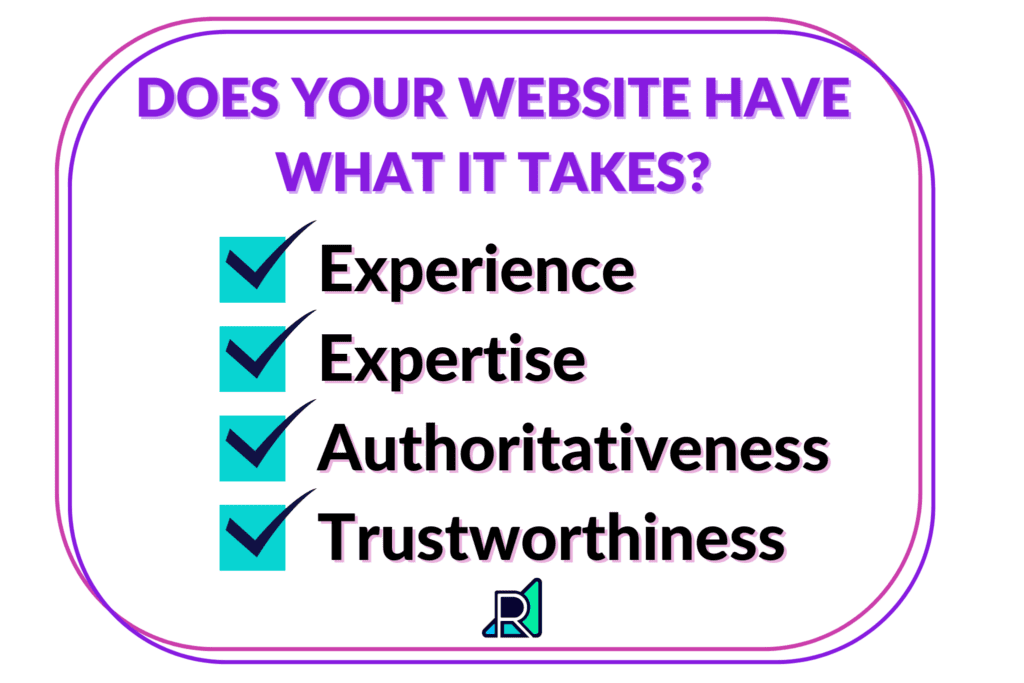
And, more than making your location clear, local search optimization contributes to your E-E-A-T—a key factor in how Google assesses your content’s Experience, Expertise, Authoritativeness, and Trustworthiness.
How to Optimize Content for Engagement and Conversion
Search engine optimization strategies help your content rank higher in search results. But once a visitor has clicked on the link to our content, you want them to be engaged and, in most cases, take a specific action.
Review the content optimization strategies below to better equip your content for engagement and conversion.
Decide What Type of Conversion You’re After and How That Connects With Your Target Keyword(s)
We’ve talked before about understanding the search intent behind your chosen keywords.
When creating or optimizing content, be sure to have realistic expectations for how each page will perform based on the type of conversion and the target keyword.
Some conversion types you may use include…
- Subscribing to your newsletter
- Buying a product or service
- Completing a survey
- Visiting a partner’s website
- Joining a waitlist
- Reading the content
- Subscribing to your newsletter
- Buying a product or service
- Completing a survey
- Visiting a partner's website
- Joining a waitlist
- Reading the content
That last conversion type can be tricky when it comes to measuring the impact of a piece of content. If you create a “How To” blog post, you should use an informational keyword. However, informational keywords do not typically convert. Instead, they increase traffic and influence your website’s overall E-E-A-T score with search engines.
If your primary goal is to boost conversions, you should focus on transactional keywords. But, well-rounded content optimization strategies create the most sustainable impact. Be careful not to discount other types of keywords just because they may not demonstrate an immediate, measurable result.
Include Conversion Elements with Strategy and Empathy
One of the most common issues we’ve encountered with our clients is knowing how and when to use calls to action, or CTAs.
No matter how compelling our content is, our audience won’t know what we want from them unless we ask.
It is essential to understand what kind of action our audience is ready for, and then present them with an opportunity to take it.
For example, let’s say you’ve created an FAQ page answering detailed questions about your most popular service. Chances are that people who land on this page and read it are ready to take the next step: speaking to someone on your team about making the purchase.
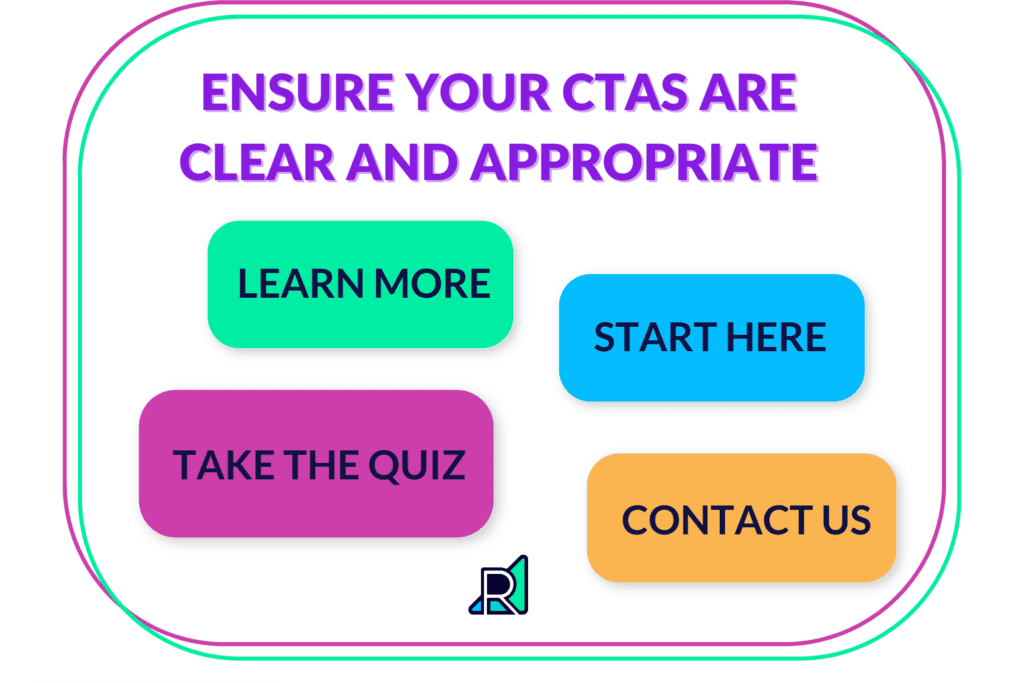
If you have not included a clear way for potential customers to contact you, they will click away, and you will have lost that conversion.
If you have included some CTA buttons, but they ask people to subscribe to a newsletter, you’ve also lost a conversion opportunity.
Effectively optimizing that page for conversion would look like…
- Placing a CTA button right below the headline and above the scroll at the top of the page
- Including a CTA button at least once halfway through the content and again at the bottom of the page.
- Incorporating a few contextual CTAs within the body text of the page.
- Creating graphs or tables near the beginning or end of the page, if it makes sense for the service
- Ensuring your contact information is clearly available in the footer, and a contact button is accessible in the header
Your goal is to make taking that action as easy as possible for the people who want to take it. Check out our popular podcast episode for detailed information about designing CTAs that work.
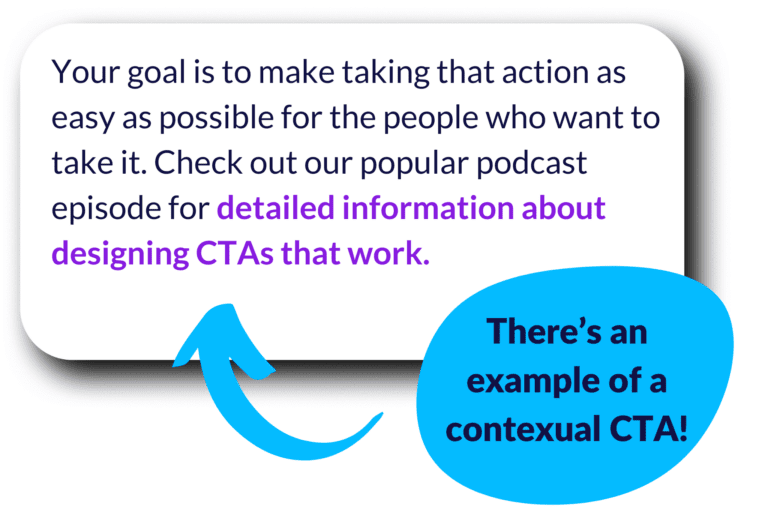
Analyze How Users Are Interacting With Your Content
To better understand how visitors engage with your website, consider using behavior analytics tools like HotJar as part of your content optimization strategy.
These tools can provide a clear visual of where visitors spend most of their time and where they begin to lose interest. This information can help you identify opportunities for optimization to make your content more engaging and effective.
For example, you may decide to move certain sections of content higher or lower on the page, expand them, or eliminate them altogether. You could also pinpoint topics your audience would like to dive deeper into.
To ensure you are putting people first in your marketing, be careful not to over-optimize into manipulation.
Before engaging in optimization tactics, it’s critical to decide what is “good enough.”

For example, it might be an anti-human tactic if your goal is to keep someone on a page (or even on an entire site) for more than a few minutes at a time.
When the CEO of Netflix says its biggest competition is sleep, we know they’ve veered into unethical, anti-human over-optimization. That’s obvious. It’s the less obvious over-optimizations—that often come first—which are the gateways to this sort of behavior that a values-driven business seeks to avoid.
So, get clear about your minimum viable actions—what the “good enough” engagements are—and where you’ll be content to quit optimizing. Extracting as much as you can from every user should never be the goal of your optimization strategy.
Use Ethical A/B Testing to Increase Your Conversion and Engagement Rates
A/B testing can be a powerful tool for content optimization strategies because it can help you learn more about your audience and increase conversion rates.
It can also be misused, leading to misleading or biased data and negatively impacting user experience.
Simply put, A/B testing is when you compare two versions of an element of your content marketing to determine which performs better.
For example, you could test two versions of an email subject line, an article headline, the wording on a CTA button, an ad image, and more.
This tool always has the potential to be used for emotional or behavioral manipulation without our audience’s consent.
However, when we prioritize providing value and enhancing our audience’s experience—with boundaries in place about how far we’re willing to go—we can gather powerful information that strengthens our connection with the communities we’re looking to serve.

How to Expand Your Reach by Using Content Amplification
Content optimization strategies help your content appear organically in search and perform better with your audience.
Content amplification expands that audience and increases traffic, engagement, and conversions.
Once you’ve invested precious resources into creating content and optimizing it to better fit your audience, be sure to take the time to celebrate your work by distributing it across the various platforms you have access to.
Content amplification can look like…
- Sharing your content on social media
- Linking your content in emails to your email list
- Using paid advertising to boost your content’s visibility on social media
- Partnering with other brands or content creators to guest blog or co-create content
- Booking podcasts or other speaking engagements where you can share your content
- Repurposing your content into different formats that will appeal to varying subsections of your audience (i.e., taking a blog post and making a YouTube video or shareable graphic about the same information).
Before you share your content on social media, be sure to optimize it for the platform.
When you share your content on social, you want to present it in a way that encourages people to share it with their own networks. Some strategies to help with this include…
- Include visuals like images, infographics, memes, and videos to improve visual appeal.
- Make sure your website has easy-to-find share buttons.
- Write compelling headlines and descriptions that will cause people to pause their scrolling.
- In your caption, promote engagement by asking questions and encouraging comments.
- Aim to post during the most active times for your specific audience on each platform.
- Tailor your caption for the different platforms you post on, keeping in mind that the audiences are slightly different for each.
- Set aside a little time each day to interact with people who have liked, shared, or commented on your posts.
Content optimization strategies are a small business owner’s best friends for making the most out of limited resources.
Creating engaging content for your business should balance between creating fresh, new content and optimizing what has already worked.
Commit to spending about 30 minutes a day on the content optimization and amplification strategies covered in this guide.
Small steps are still progress, and you may be surprised at how quickly they add up to create sustainable results that don’t leave you feeling burned out.
- Step One: Look at what content has already gotten some traction with likes, shares, clicks, or comments (digital or in-person).
- Step Two: Determine which of the strategies above can make it even better. Download our handy checklist here.
- Step Three: Celebrate and share!
Content optimization strategies don’t just help you make better content—they also shine a light on the work you’re doing and expand your impact.
Conserve your energy for the work you love by outsourcing for the work you don’t.
We love to see business founders thriving, doing the work only they can do. That’s why we’ve created a boutique selection of digital marketing solutions customized to meet the needs of our unique clients.
If you’re looking for help developing a keyword strategy, analyzing your internal linking structure, or developing backlinks, check out our services today.

